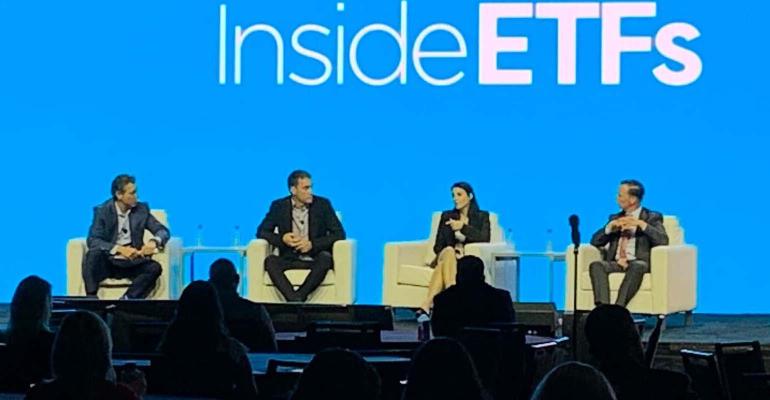With high interest rates and volatile equity markets roiling portfolios, allocations are shifting with cash, fixed income, private credit and other alternatives all drawing some interest, according to panelists at the Macro Market Overview-Future Trends in Asset Allocation session at the Inside ETFs conference as part of Wealth Management EDGE at The Diplomat Beach Resort in Hollywood Beach, Fla.
The panel featured Shana Sissel, CEO, Banrion Capital Management; Paul Santoro, head of ETF Sales, Capital Group; and Brett Orvieto, managing director, Dakota Wealth Management, and was moderated by Caleb Silver, editor-in-chief and senior vice president of content for Investopedia.
“If you have money sitting around, the boring stuff is back,” Orvieto said. “Bonds, treasuries, cash.” He pointed to tools like Flourish Cash, which helps advisors find high-yield accounts with rates north of 4% for cash.
Meanwhile Sissel—who goes by the nickname the “queen of alternatives”—pointed to private credit as the top ask among advisors she works with.
“As credit conditions tighten, it’s very attractive. It seems to be where advisors are really looking,” she said. It’s a trend she thinks could accelerate further with the rising popularity of interval funds. Although the structure has been around for a while, volume has begun to tick up in recent years with the entrance of new players. And other sponsors are queueing up to enter the playing field later in 2023 and early in 2024.
“I’m hearing a lot from private equity, private credit and venture capital firms that they will be launching products in that space,” Sissel said. “These are areas that have not been accessible for average investors.”
But Sissel acknowledged barriers remain for wider adoption of some alt products.
“The biggest problem is that they are complicated,” she said. “If you chase returns in alts you might end up in a product you are very unhappy with.”
However, it’s education that advisors need to best serve as fiduciaries, she said.
“We teach advisors how to build equity portfolios and we teach them how to build fixed income portfolios,” she said. “But it’s the same in alts. (There’s a tendency) to put all alts in one book. But there are diversifying alts. There are private market alts. … There are opportunities to generate excess return and alpha. At the end of the day, it’s still equity. It’s still credit.”
Santoro, meanwhile, said the fixed income space is offering attractive yields and fixed-income ETFs could be a good option for investors.
“There’s a belief in the ETF space that ‘passive’ equaled tax efficient. Really, it’s the wrapper that makes ETFs tax efficient, not the fact that they are passive.” Santoro said. “People need to understand the tax efficiency extends to the active space as well.”
The active ETF space is now approaching $1 trillion in volume. More notable, Santoro said, is that in the first quarter of 2023, 31% of flows went to active ETFs even though they only represent 5% of total ETF assts.
“That’s something that advisors are hearing from their clients,” he said. “All of the money that poured out of fixed income funds may flow back. And ETFs will play an important part of that.”
Still, despite some of the exploration around new asset allocation models, Orvieto defended the classic 60/40 portfolio.
“Last year was catastrophic for the 60/40 portfolio. … But people also understand that’s not a regular occurrence,” he said. “The opportunity set going forward is a lot better. There’s a 5% to 6% yield in the 40 part of the portfolio right now."





